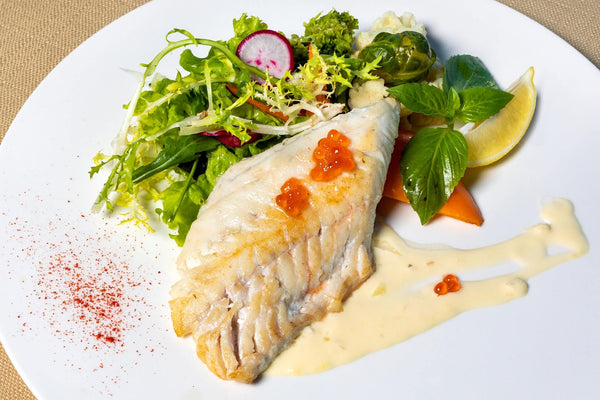The Best Way to Cook Halibut (I Tried and Tested in My Kitchen)
Updated on Jun 20, 2025
Cooking halibut isn’t as straightforward as it seems. With its lean, delicate flesh, one small mistake can leave you with a dry, disappointing piece of fish. That’s why I decided to test several popular methods right in my own kitchen to find out which one actually works best. If you’ve ever wondered how to cook halibut so it turns out moist, flavorful, and restaurant-worthy every time — keep reading.
Why Halibut Can Be Tricky to Cook
Halibut is one of those fish that can go from perfect to overcooked in just seconds. Its lean, firm white flesh makes it incredibly delicate. Unlike fattier fish like salmon, halibut doesn’t have much oil to protect it during cooking. That means if you’re not careful, it can quickly dry out, turn rubbery, or lose its mild, sweet flavor. Even professional chefs will tell you that getting halibut just right takes a bit of finesse. The key is finding a cooking method that keeps it moist while bringing out its natural taste.
Related: What Does Halibut Taste Like?
I Tried 3 Popular Methods to Cook Halibut
To find out which cooking method brings out the best in halibut, I tested four of the most common ways people prepare it at home. Each technique has its own strengths, and I wanted to see which one delivers the perfect balance of flavor, texture, and ease.
Here are the methods I put to the test:
Pan-seared
Pan-searing halibut might sound intimidating, but it’s surprisingly simple and delivers excellent results. I started by patting the fillets completely dry and seasoning them lightly with salt and pepper. Then I heated a bit of oil in a non-stick skillet until it shimmered, carefully placing the fillets skin-side down.
The key is to let the fish cook undisturbed for a few minutes to develop a beautiful golden crust. Once the edges turned opaque, I gently flipped it and cooked for another couple of minutes on the other side. The inside stayed moist, while the outside had a nice crisp texture. With the short cook time and minimal prep, pan-searing gave me perfectly cooked halibut with a mild, clean flavor that really let the fish shine.
Baked
Baking halibut is one of the most forgiving methods, especially if you’re nervous about overcooking it. I placed the fillets in a baking dish, drizzled them with olive oil, and added a few lemon slices and herbs on top for extra flavor. Then I baked them in a preheated 400°F oven.
The steady, even heat gently cooked the halibut all the way through. The texture came out tender and flaky, though it lacked the crispness you get from pan-searing. It’s a great method if you want a simple, hands-off approach, especially for larger portions or dinner parties. The flavor stayed mild, and the halibut easily absorbed the aromatics I added.
Poached
Poaching halibut is perfect if you want something ultra-tender and moist. I simmered a flavorful broth with white wine, lemon, garlic, and a few sprigs of fresh herbs. Once the liquid was barely bubbling, I gently lowered the halibut fillets into the pan.
Because the fish cooks slowly at a low temperature, it stayed incredibly juicy and soft. The mild broth infused the halibut with a subtle, delicate flavor. The downside? It’s easy to accidentally overcook if you're not watching closely, and the texture can be a bit too soft for some people who prefer a firmer bite. Still, it’s a great option when you want a very light, elegant preparation.
After trying each one, I was able to compare how they stack up — from taste to tenderness to overall convenience.
The Winner: My Favorite Way to Cook Halibut
After testing all four methods, pan-searing easily came out on top. It delivered the best balance of flavor, texture, and visual appeal. The golden crust gave each bite a satisfying contrast to the moist, tender interior. Plus, the quick cooking time meant I didn’t have to worry about drying it out.
While baking, poaching, and grilling each have their place, nothing matched the restaurant-quality results I got from pan-searing right in my own kitchen. It’s now my go-to method whenever I cook halibut at home.
How to Cook Halibut
If you want to try pan-searing halibut at home, here’s exactly how I do it:
- Start with fresh, high-quality halibut: Look for firm, bright white fillets with no strong odor. If you're using frozen, thaw it overnight in the fridge.
- Pat the fillets completely dry: Moisture on the surface prevents a good sear. Use paper towels to dry both sides thoroughly.
- Season simply: A light sprinkle of kosher salt and freshly ground pepper is all you need. The clean flavor of halibut shines on its own.
- Heat your pan: Place a non-stick or stainless steel skillet over medium-high heat. Once hot, add a tablespoon of neutral oil (like avocado or canola oil) and swirl to coat.
- Sear the fish: Place the fillets skin-side down (or presentation side down if skinless). Don’t move them for 3-4 minutes — this allows a golden crust to form.
- Flip carefully: Use a thin spatula to gently turn the fillets. Cook for another 2-3 minutes on the other side, depending on thickness.
- Check for doneness: The halibut should flake easily with a fork but still be moist inside. Internal temp should read 130°F–135°F for perfect doneness.
- Rest and serve: Let the fish rest for a minute before serving. A squeeze of fresh lemon or a light sauce pairs perfectly.
Kyle’s Tips When Cooking Halibut
Over the years, I’ve learned a few simple tricks that make a big difference when cooking halibut at home:
- Don’t skip drying the fillets: Even a little moisture can prevent a good sear and lead to steaming instead of browning.
- Use high-quality oil with a high smoke point: Oils like avocado, grapeseed, or canola can handle the high heat needed for a proper sear.
- Let the fish come to room temperature: Taking the fillets out of the fridge 15-20 minutes before cooking helps them cook more evenly.
- Watch the heat: Too hot and you risk burning the exterior before the inside is done; too low and you won’t get that golden crust.
- When in doubt, slightly undercook: Halibut will continue cooking a bit once removed from the pan. Pulling it off the heat just before it’s fully opaque helps prevent dryness.
FAQs About Cooking Halibut
Can you cook halibut frozen?
Yes, but it’s not ideal. Cooking halibut straight from frozen can lead to uneven results. For best texture and flavor, thaw it slowly in the refrigerator overnight.
Related: The Best Frozen Halibut to Buy
What temp should halibut be cooked to?
Aim for an internal temperature of 130°F to 135°F. This keeps the halibut moist and flaky without drying it out. Going much higher can make it tough.
Related: Cooking Halibut Temperature Guide
How do you keep halibut from drying out?
The key is controlling temperature and time. Use a hot pan, avoid overcooking, and let the fillets rest briefly before serving. Adding a sauce or finishing with butter can also help lock in moisture.
Should I cook halibut with skin on or skin off?
Both work. Skin-on fillets can help protect the flesh during cooking and add a bit of texture if crisped well. If your fillet is skinless, just be extra careful not to overcook since it has less protection.
Summary
Halibut can be a little tricky to get right, but once you nail the technique, it’s one of the most rewarding fish to cook at home. After testing pan-seared, baked, poached, and grilled methods, pan-searing clearly stood out as my personal favorite. The quick cooking time, beautiful golden crust, and moist, flaky interior make it hard to beat. Whether you’re cooking halibut for a weeknight dinner or a special occasion, a simple pan-sear brings out its clean, mild flavor perfectly.







